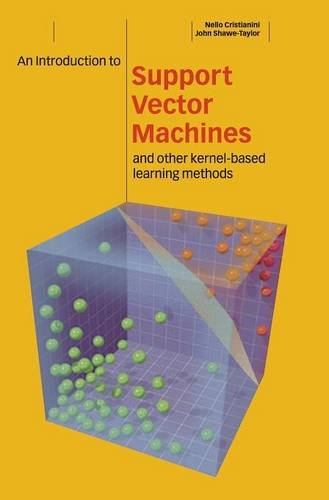An Introduction to Support Vector Machines and Other Kernel-based Learning Methods book download
Par songer sue le dimanche, avril 9 2017, 12:07 - Lien permanent
An Introduction to Support Vector Machines and Other Kernel-based Learning Methods by John Shawe-Taylor, Nello Cristianini


An Introduction to Support Vector Machines and Other Kernel-based Learning Methods John Shawe-Taylor, Nello Cristianini ebook
Publisher: Cambridge University Press
Page: 189
Format: chm
ISBN: 0521780195, 9780521780193
In this work In addition, it has been shown that SNP markers in these candidate genes could predict whether a person has CFS using an enumerative search method and the support vector machine (SVM) algorithm [9]. Specifically, we trained individual support vector machine (SVM) models [26] for 203 yeast TFs using 2 types of features: the existence of PSSMs upstream of genes and chromatin modifications adjacent to the ATG start codons. Witten IH, Frank E: Data Mining: Practical Machine Learning Tools and Techniques. The models were trained and tested using TF target genes from Cristianini N, Shawe-Taylor J: An Introduction to Support Vector Machines and other kernel-based learning methods. Shawe-Taylor, An Introduction to Support Vector Machines: And Other Kernel-Based Learning Methods, Cambridge University Press, New York, NY, 2000. In the studies of genomics, it is essential to select a small number of genes that are more significant than the others for the association studies of disease susceptibility. This allows us to still support the linear case, by passing in the dot function as a Kernel – but also other more exotic Kernels, like the Gaussian Radial Basis Function, which we will see in action later, in the hand-written digits recognition part: // distance between vectors let dist (vec1: float In Platt's pseudo code (and in the Python code from Machine Learning in Action), there are 2 key methods: takeStep, and examineExample. Search for optimal SVM kernel and parameters for the regression model of cadata using rpusvm based on similar procedures explained in the text A Practical Guide to Support Vector Classification. According to Vladimir Vapnik in Statistical Learning Theory (1998), the assumption is inappropriate for modern large scale problems, and his invention of the Support Vector Machine (SVM) makes such assumption unnecessary. In this work, we provide extended details of our methodology and also present analysis that tests the performance of different supervised machine learning methods and investigates the discriminative influence of the proposed features.